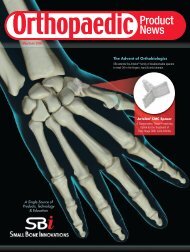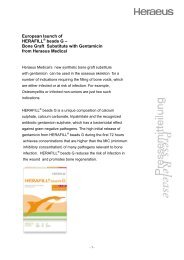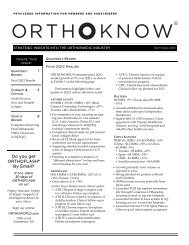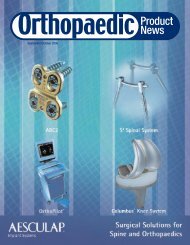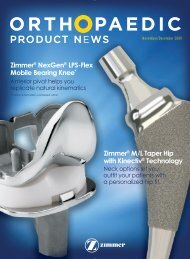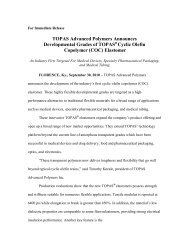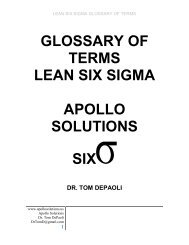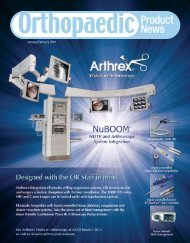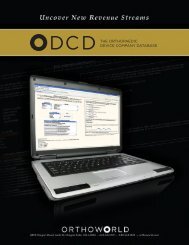Spinal Surgery, Cement Systems - Orthoworld
Spinal Surgery, Cement Systems - Orthoworld
Spinal Surgery, Cement Systems - Orthoworld
Create successful ePaper yourself
Turn your PDF publications into a flip-book with our unique Google optimized e-Paper software.
POSITION PAPER<br />
ORTHOWORLD<br />
Position Paper On<br />
Healthcare Reform<br />
Prepared by ORTHOWORLD Inc.<br />
Published August 5, 2009<br />
As the healthcare reform initiative moves through the halls of<br />
Washington, we will undoubtedly be debating what treatments<br />
do and do not work and what options should be made available<br />
to the American people. When we enter these heated discussions,<br />
it is imperative that the facts be examined that allow<br />
evaluation of medical procedures and their effectiveness in<br />
returning the health and productivity of the citizenry.<br />
Orthopaedic care has clearly demonstrated its efficacy. Without<br />
question. It has changed tens of millions of lives for the better,<br />
forever.<br />
Orthopaedic problems and interventions affect us all at one<br />
time or another in our lives. The National Center for Health<br />
Statistics estimates that nearly 108 million American adults<br />
reported bone and joint medical conditions in 2005. 1 That’s<br />
nearly half of all Americans over the age of 18. Musculoskeletal<br />
disorders and conditions are the leading cause of disability in<br />
the U.S. and the most frequently cited reasons for limitations in<br />
daily activities of life, with 15 million Americans aged 18+<br />
limited by arthritis, back or neck problems, fractures, connective<br />
tissue conditions, etc. More Americans report musculoskeletal<br />
conditions than either circulatory (heart disease, stroke, etc.) and<br />
respiratory (emphysema, asthma, hay fever, bronchitis, etc.)<br />
problems and musculoskeletal conditions remain the greatest<br />
cause of lost work days and medical bed days in the U.S.(ibid)<br />
In 2004, an estimated $849 billion was spent in health care<br />
costs and lost wages for Americans with a musculoskeletal<br />
diagnosis. That’s nearly eight percent of our national gross<br />
domestic product.”(ibid) Furthermore, days lost from work<br />
neared 438 million, costing workers $339 billion in aggregate<br />
earnings.(ibid)<br />
Among the most prevalent musculoskeletal problems are<br />
arthritis and back pain.<br />
Arthritis afflicts 47 million Americans and by 2030, nearly 67<br />
million Americans (or about 25 percent of the adult population)<br />
could suffer with arthritis. The most common form of arthritis,<br />
osteoarthritis, afflicts 27 million Americans 2 and is the leading<br />
diagnosis underlying the need for joint replacement<br />
procedures. 3<br />
Joint replacement has been shown to be one of the most<br />
highly effective procedures in the history of medicine. Of hip<br />
and knee devices implanted ten years ago, more than 90 percent<br />
remain in place and functional. Few appliances devised by<br />
humankind can offer such a longevity claim. Furthermore, study<br />
after study supports the cost/benefit of joint replacement. For<br />
instance, two studies found that the cost of surgical intervention<br />
for knee arthritis averaged $35,000, while costs for non-intervention<br />
neared $104,000. A similar dynamic surrounded hip replacement<br />
with intervention costing $40,750 vs. $223,094 for nonintervention,<br />
largely due to reduced custodial care. 4,5 In 2007,<br />
some 804,000 primary total hip (THA) and total knee (TKA)<br />
replacement procedures were performed in the U.S.(3)<br />
Combined, these two procedures provided the “system” with<br />
lifetime savings of more than $80 billion.<br />
A study in Canada determined that “THA and TKA result in<br />
significant gains in quality-adjusted life expectancy, and can be<br />
considered cost-effective when compared to other elective<br />
surgical procedures.” 6 Researchers in Spain arrived at similar<br />
conclusions, stating that “the costs of both knee and hip replacement<br />
compare favorably with other medical or surgical<br />
procedures.” 7<br />
According to Burden of Musculoskeletal Diseases in the United<br />
States, “Joint replacement procedures are proven to be one of the<br />
most successful procedures available today. In the vast majority<br />
of cases, the procedure significantly improves quality of life and<br />
the patient’s ability to continue work, activities of daily living,<br />
and recreational activities.”<br />
While many believe joint replacement to be an elderly<br />
“problem,” it is not. Innovations developed by the orthopaedic<br />
community have made joint replacement more accessible to a<br />
younger patient group and more and more younger patients are<br />
benefiting from joint replacement. For example, in 1997, 26<br />
percent of primary total hip and knee procedures were<br />
performed on patients between 45 and 64 years of age. By 2007,<br />
these younger patients accounted for 40 percent of all primary<br />
total hip and knee replacement patients. 4 These patients are the<br />
lifeblood of our future, the workers of tomorrow whose very<br />
health and activity will fuel growth in our economy. We need<br />
them to be active and productive members of society.<br />
Estimated direct medical costs for arthritis and joint pain<br />
patients in 2004 exceeded $281 billion. Some $22 billion was<br />
attributed to the indirect cost of lost earnings for those aged 18<br />
to 64. 1<br />
These younger workers are also the primary age group<br />
afflicted by low back pain. In 2004, for instance, some 74 percent<br />
continued on page 31<br />
30 ORTHOPAEDIC PRODUCT NEWS • September/October 2009



